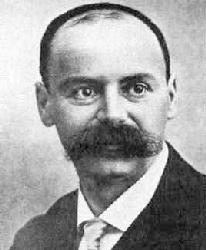




Born on October 9 1873 in Frankfurt am Main, Karl Schwarschild started interesting himself in astronomy as a teenager. He studied at Strasbourg and Munich, where he obtained his doctorate in 1896. From 1896 to 1899 he worked at Von Kuffner Observatory in Vienna. In 1901, following a few years as a Lecturer in Munich, be secured a Faculty position at G�tingen University, where he also became director of the observatory. In 1909 he became director of the Postdam Observatory. Holding deep nationalistic convictions, despite his 40 years of age Schwarzschild volunteered in the german army at the beginning of World War I. He served on both the Eastern and Western fronts, rising to the rank of atillery lieutenant. Struck with a rare incurable skin disease possibly linked to expose to chemical weapons widely used in this war that was hoped to end all wars, Schwarzschild was discharged in March 1916 and returned home to Potsdam to die two months later, on May 11.
Nowadays Schwarzschild is mostly remembered for his remarkable mathematically exact solution to Einstien's field equations, which lead to the idea of black holes, even more remarkable considering that Schwarszschild worked this out while fighting in Russia. However, in his own days Schwarzschild was mostly recognized as a leading expert in stellar structure. His work on convective stability and radiative transfer and equilibrium in stellar atmospheres laid the groundwork for all future work on these topics, and remain valid today. Schwarzschild was elected foreign member of the Royal Astronomical Society in 1909, et of the Prussian Academy of Sciences in 1913.
http://www-history.mcs.st-andrews.ac.uk/Biographies/Schwarzschild.html
 To search for a Solar Physicist
To search for a Solar Physicist
![]() To references and further reading
To references and further reading
last modification on january 18 2008 by
paulchar@astro.umontreal.ca
Tous droits réservés / Copyrighted by
Université de Montréal